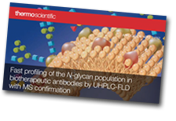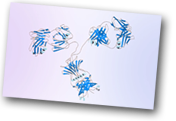Want to know more about biopharmaceutical characterization? Need help with your protein analysis or peptide mapping, require improved applications for glycan analysis or struggle with your chromatography or mass spectrometry? If so, this educational microsite has the answers...
Separation Science, in collaboration with Thermo Fisher Scientific, has launched a learning hub for biopharmaceutical scientists covering key analytical issues revolving around the characterization of biotherapeutics. Topics covered on this site include:
Peptide Mapping Peptide mapping is a critical workflow in biotherapeutic protein characterization and is essential for elucidating the primary amino acid structure of proteins. For recombinant protein pharmaceuticals, such as monoclonal antibodies (mAbs) and antibody-drug conjugates (ADCs), peptide mapping is used for proof of identity, primary structural characterization and quality assurance/quality control (QA/QC).
Peptide mapping is a critical workflow in biotherapeutic protein characterization and is essential for elucidating the primary amino acid structure of proteins. For recombinant protein pharmaceuticals, such as monoclonal antibodies (mAbs) and antibody-drug conjugates (ADCs), peptide mapping is used for proof of identity, primary structural characterization and quality assurance/quality control (QA/QC).
Glycan Analysis Glycans serve a variety of structural and functional roles in membrane and secreted proteins, with the majority of proteins undergoing some degree of glycosylation during their synthesis. Regulatory agencies worldwide, including the FDA and EMA, are increasing the demands placed upon manufacturers to comprehensively analyze the glycosylation of their therapeutics, and also to demonstrate how process can affect glycan composition.
Glycans serve a variety of structural and functional roles in membrane and secreted proteins, with the majority of proteins undergoing some degree of glycosylation during their synthesis. Regulatory agencies worldwide, including the FDA and EMA, are increasing the demands placed upon manufacturers to comprehensively analyze the glycosylation of their therapeutics, and also to demonstrate how process can affect glycan composition.
Native Mass Analysis The complexity of modern therapeutic proteins presents a significant analytical challenge requiring high-resolution chromatography combined with high-resolution mass spectrometry. Intact protein analysis under native mass spectrometric conditions can now be performed routinely using mass spec friendlly buffers together with size exclusion (SEC) or ion exchange chromatography (IEC) coupled to Q Exactive BioPharma series mass spectrometers.
The complexity of modern therapeutic proteins presents a significant analytical challenge requiring high-resolution chromatography combined with high-resolution mass spectrometry. Intact protein analysis under native mass spectrometric conditions can now be performed routinely using mass spec friendlly buffers together with size exclusion (SEC) or ion exchange chromatography (IEC) coupled to Q Exactive BioPharma series mass spectrometers.
Aggregate Analysis Aggregation of therapeutic proteins can result in an incorrect drug dosage, or an undesired and potentially fatal immune response. Consequently, monitoring protein aggregates is important for safety and quality assurance. Investigators routinely use size-exclusion chromatography (SEC), which separates particles according to hydrodynamic size. Recently the use of hydrophobic interaction chromatography (HIC) has also received great interest as an orthogonal technique to SEC. HIC separates proteins based on the hydrophobicity in the native state and can often detect changes in protein structure as well as aggregates.
Aggregation of therapeutic proteins can result in an incorrect drug dosage, or an undesired and potentially fatal immune response. Consequently, monitoring protein aggregates is important for safety and quality assurance. Investigators routinely use size-exclusion chromatography (SEC), which separates particles according to hydrodynamic size. Recently the use of hydrophobic interaction chromatography (HIC) has also received great interest as an orthogonal technique to SEC. HIC separates proteins based on the hydrophobicity in the native state and can often detect changes in protein structure as well as aggregates.
Charge Variant Analysis Biotherapeutic proteins such as monoclonal antibodies (mAbs) are far more heterogeneous than small-molecule drugs. The presence of the charged state can significantly impact the structure, stability, binding affinity, and efficacy of the biotherapeutic drug. It is therefore necessary to understand the profile of the drug so that charge variants are identified and removed if necessary. The heterogeneity of monoclonal antibodies is revealed by charge sensitive methods, such as ion exchange chromatography (IEX).
Biotherapeutic proteins such as monoclonal antibodies (mAbs) are far more heterogeneous than small-molecule drugs. The presence of the charged state can significantly impact the structure, stability, binding affinity, and efficacy of the biotherapeutic drug. It is therefore necessary to understand the profile of the drug so that charge variants are identified and removed if necessary. The heterogeneity of monoclonal antibodies is revealed by charge sensitive methods, such as ion exchange chromatography (IEX).
Don't miss out on this unique learning platform...




